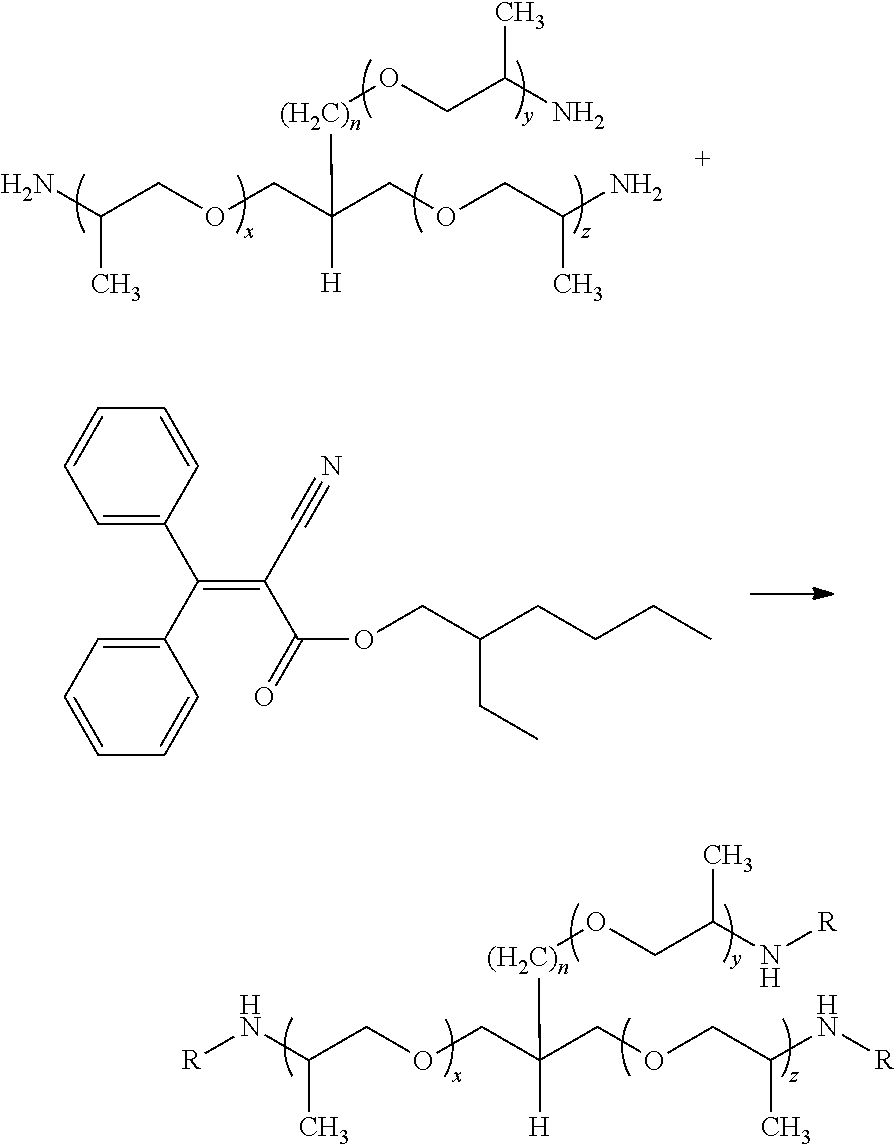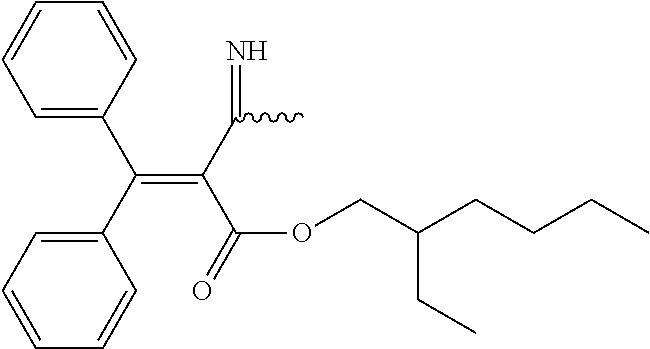Ultraviolet-Absorbing Compounds
a technology of ultraviolet radiation and absorbers, applied in the field of compounds, can solve the problems of increased risk of developing such conditions, short and long-term skin damage, and serious health hazards of ultraviolet radiation, and achieve the effects of improving water-proofness, reducing skin penetration tendency, and stabilizing ultraviolet radiation absorbers
- Summary
- Abstract
- Description
- Claims
- Application Information
AI Technical Summary
Benefits of technology
Problems solved by technology
Method used
Image
Examples
embodiment 1
[0052]In the first embodiment of the invention, the ultraviolet-absorbing compound is synthesized by reacting at least one first reactant being a UV absorber comprising a carbon-nitrogen triple bond with at least one second reactant comprising amine functionality. Such reactions are known to one skilled in the art, and an interested reader is referred to one of the many texts on the subject, such as Organic Chemistry by Morrison and Boyd (1992), which is hereby incorporated in its entirety by reference.
First Reactant, UV Absorber Comprising Carbon-Nitrogen Triple Bond
[0053]An especially preferred family of first reactants (i.e., UV absorbers) that meets the requirements of the first embodiment of the invention is the family of cyanoacrylates, including the structure represented below:
wherein R1, and R3 are independently selected from hydrogen, functionalized and unfunctionalized alkyl, cycloalkyl, alkenyl, and aryl groups, wherein any of the before mentioned groups may be present wi...
embodiment 2
[0085]Novel ultraviolet-absorbing compounds of the invention also are described by a second embodiment. They may be synthesized by reacting at least one first reactant being a UV absorber having amine functionality with at least one second reactant possessing a carbon-nitrogen triple bond.
First Reactant, UV Absorbers having Amine Functionality
[0086]UV absorbers comprising at least one amine group are known, and include the following compounds: benzophenone-5; bisdisulizole disodium (Neo Heliopan® AP); diethylhexyl butamido triazone (iscotrizinol); menthyl anthranilate (meradimate); p-aminobenzoic acid; phenylbenzimidazole sulfonic acid (ensulizole, Eusolex® 232); N,N′-bisformyl-N,N′-bis-(2,2,6,6-tetramethyl-4-piperidinyl)-hexamethylendiamine (Uvinul® 4050 H); bis-(2,2,6,6-tetramethyl-4-piperidyl)-sebacate (Uvinul® 4077 H, Uvinul® 4077 GR); sterically-hindered amine CAS #152261-33-1 ; 2,6-di-tert-butyl-4-[4,6-bis(octylthio)-1,3,5-triazin-2-ylamino]phenol (Irganox® 565); N,N′-hexane-1...
example 1
[0200]
wherein R═
[0201]A diamine-terminated polypropylene glycol having an approximate molecular weight of 2,000 g / mol (Jeffamine® D2000, Huntsman Corporation) {100 g) and octocrylene (Escalol® 597, International Specialty Products) (30 g) were charged into a 0.5 L, four-necked resin kettle equipped with an anchor agitator, a thermocouple, a condenser, and a nitrogen surface purge adaptor.
[0202]The agitator was turned on to 200 rpm and the mixture was heated to 100° C. in 30 minutes. During the entire reaction, nitrogen was purged through the reacting mixture. Once the temperature reached 100° C., the kettle was maintained isothermally for 1 hour. Then, the temperature was increased to 180° C. within 30 minutes, and the kettle was held at this higher temperature for 5 hours. A vacuum was pulled for the final 4 hours to remove the excess volatile materials.
[0203]The synthesized polymer has a theoretical molar ratio of 1.2 effective amine units: 1 UV absorber.
PUM
| Property | Measurement | Unit |
|---|---|---|
| wavelengths | aaaaa | aaaaa |
| wavelengths | aaaaa | aaaaa |
| wavelengths | aaaaa | aaaaa |
Abstract
Description
Claims
Application Information
 Login to View More
Login to View More - R&D
- Intellectual Property
- Life Sciences
- Materials
- Tech Scout
- Unparalleled Data Quality
- Higher Quality Content
- 60% Fewer Hallucinations
Browse by: Latest US Patents, China's latest patents, Technical Efficacy Thesaurus, Application Domain, Technology Topic, Popular Technical Reports.
© 2025 PatSnap. All rights reserved.Legal|Privacy policy|Modern Slavery Act Transparency Statement|Sitemap|About US| Contact US: help@patsnap.com



